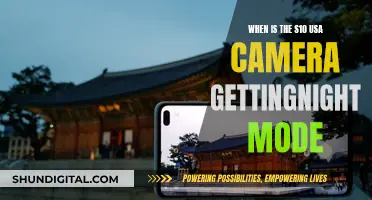
Smartphone cameras are made up of three basic parts: the lens, the sensor, and the software. The lens is a piece of polished, transparent material (plastic or glass) that directs light onto the camera sensor. The focal length of a phone camera determines the field of view (how wide or narrow the photo will be). The aperture is the opening that decides how much light will enter through the lens and is measured in f-stops, with a lower f-number indicating a wider aperture. The sensor is a thin wafer of silicon that converts photons (light) into electrons (electrical signals). Finally, the software converts the electrical signals into a photo.
What You'll Learn
- Lenses: Made of glass or plastic, they focus light on the camera sensor
- Sensors: Converts light into electrical signals, with higher megapixels capturing more detail
- Image Signal Processors: The brain of the camera, converting signals into viewable images
- Aperture: Controls the amount of light entering the lens, with wider apertures capturing more light
- Focal Length: Determines the field of view, or how wide or narrow the photo will be

Lenses: Made of glass or plastic, they focus light on the camera sensor
Lenses are a crucial component of smartphone cameras, responsible for focusing light onto the camera sensor to create sharp images. They are typically made of plastic due to the complexity and size constraints of modern smartphones.
The lens is usually a round, transparent piece of material with two polished surfaces that curve inwards or outwards, depending on the type of lens. In smartphone cameras, a compound lens is used, consisting of multiple lens elements made from plastic. This is because plastic lenses are lightweight, shock-resistant, and can be mass-produced through injection moulding, making them ideal for the small form factor of mobile phones.
The primary function of a lens is to bend light. When light rays pass through a lens, they change direction due to the difference in the speed of light in air and the lens material. Convex lenses, which curve outwards, bend light inwards towards a focal plane, while concave lenses, which curve inwards, spread light outwards.
The smartphone camera lens contains a series of convex and concave lenses of varying densities that work together to direct light towards the sensor. This combination of lenses ensures that the camera captures an image that is sharp and clear across the entire frame.
The quality and positioning of these lens elements are critical to achieving optimal image quality. Any misalignment or defects in the lenses can result in issues such as chromatic aberration, blurring, and reduced contrast in the final image.
Additionally, the focal length of the lens also plays a role in determining the angle of view and the magnification of the image. Smartphone cameras often have multiple lenses with different focal lengths, allowing for features such as optical zoom and improved low-light performance.
In summary, the lenses in smartphone cameras are carefully designed and manufactured to focus light onto the camera sensor, utilising the properties of plastic materials to create high-quality, crisp images within the constraints of a compact smartphone design.
Activating Kingdom Hearts 3's Camera Mode: A Quick Guide
You may want to see also

Sensors: Converts light into electrical signals, with higher megapixels capturing more detail
The sensor is one of the most important parts of a smartphone camera. It is a thin wafer of silicon that converts photons (light) into electrons (electrical signals) through a process called photovoltaic conversion. This conversion happens at millions of photosites across the tiny surface of the sensor. If no photons reach a photosite, the sensor registers that pixel as black. Conversely, if many photons reach a photosite, the pixel is white. The number of shades of grey the sensor can distinguish is known as its bit depth.
Each photosite is overlaid with a colour filter that only lets through certain colours of light. The most common type of filter array is the Bayer colour filter array, which divides every 2x2 square of photosites into one red, one blue, and two green filters (RGGB). An exception to this is Huawei's SuperSpectrum sensors, which use yellow filters (RYYB) instead of green to allow more light through, improving luminance data. The resulting mosaic of colour and light data must then be converted into a full-colour image using complicated demosaicing algorithms.
The number of photosites on a sensor is known as its megapixel count. One megapixel is equal to one million pixels. Higher megapixel counts allow the camera to capture more detail, but this is not the only factor that determines image quality. The size of the photosites, or pixels, is also important. Larger pixels can capture more light, resulting in better low-light performance. However, smaller pixels do not necessarily mean lower-quality photos. For example, Samsung compensates for small photosites by "binning" multiple photosites together, allowing more light to be collected.
In recent years, smartphone manufacturers have been increasing the size of the sensor to improve light sensitivity. A larger sensor has more space for larger pixels, which can capture more light. This results in better low-light performance and a higher signal-to-noise ratio, leading to improved image quality.
Understanding DVR Mode on Stealth Cameras
You may want to see also

Image Signal Processors: The brain of the camera, converting signals into viewable images
The image signal processor (ISP) is a crucial component in modern smartphone cameras. It is responsible for converting raw image data captured by the device into high-quality, viewable images. This process involves several steps and sophisticated tasks performed by the ISP.
Firstly, the ISP communicates with the image sensor to extract raw data from each pixel on the sensor's surface. It interprets this data to understand the intensity of light hitting each pixel, which forms the basis for creating a high-quality image. The ISP also reduces noise, especially in low-light conditions, to improve image smoothness and eliminate graininess.
One of the key functions of the ISP is colour correction and enhancement. It corrects colour imbalances caused by poor lighting, colour temperature, or sensor limitations, enhancing the vibrancy and fidelity of the image. The ISP may use a Bayer colour filter array, a mosaic of red, green, and blue colour filters, to capture light intensity data and then employ demosaicing algorithms to insert missing colour information, resulting in a full-colour image.
The ISP also plays a role in auto-exposure and auto-focus. It determines the optimal exposure settings by analysing and adjusting the brightness, aperture, shutter speed, and ISO to ensure the image is neither too light nor too dark and has sharp focus. Additionally, the ISP adjusts the white balance by correcting the colour temperature to ensure whites appear neutral, regardless of the lighting conditions.
In addition to these primary functions, the ISP also enables advanced features such as HDR correction, damaged pixel repair, and AI correction to further enhance image quality. It handles image compression to reduce file size without compromising quality, making it possible to capture multiple images and receive high-quality results, even in limited storage space devices.
The ISP's ability to process and enhance image data has revolutionised photography, making it easier for people to capture high-quality, visually appealing images with their smartphone cameras.
Square Mode Photography: Capturing Unique Moments with a Twist
You may want to see also

Aperture: Controls the amount of light entering the lens, with wider apertures capturing more light
Aperture is a crucial aspect of smartphone camera functionality, as it determines the amount of light that enters the lens and reaches the camera sensor. A wider aperture allows more light to pass through, enhancing low-light photography capabilities.
The aperture is the opening in the lens through which light enters the camera. It is measured in f-stops, which represent the ratio of the camera's focal length to the physical diameter of the aperture. A lower f-stop number indicates a wider aperture; for example, f/1.7 is a wider aperture than f/2.
In smartphone cameras, the aperture plays a significant role in capturing clear and stable photos, especially in low-light conditions. By allowing more light to reach the sensor, wider apertures enable the camera to capture brighter and sharper images, even in dimly lit environments. This is particularly advantageous for mobile photography, as it compensates for the smaller size of lenses and sensors in smartphones, which inherently receive less light.
The aperture also influences the depth of field in an image. A wider aperture results in a shallower depth of field, blurring the background and foreground while keeping the subject in focus. This effect is often utilised in portrait mode to emphasise the subject. Conversely, a narrower aperture increases the depth of field, keeping more of the scene in focus.
Smartphone cameras typically have a fixed aperture, which means it cannot be manually adjusted. However, advancements in smartphone camera technology have introduced variable apertures, providing photographers with more creative control over their images. With a variable aperture, users can optimise low-light image quality and depth of field, capturing sharper and more versatile photos.
The aperture is an essential component of the exposure triangle in photography, alongside shutter speed and ISO. By controlling the aperture, photographers can manipulate the amount of light reaching the sensor, affecting the overall exposure and image quality.
Charging Your Xiaomi Yi Camera: A Quick Guide
You may want to see also

Focal Length: Determines the field of view, or how wide or narrow the photo will be
Focal Length and Field of View
The focal length of a lens is a fundamental parameter that defines how strongly it focuses or converges light. A longer focal length indicates that light is bent gradually, while a shorter focal length indicates that light is bent at sharp angles. In general, lenses with positive focal lengths converge light, while those with negative focal lengths cause light to diverge.
The focal length of a lens determines its field of view, or how wide or narrow the photo will be. Field of view describes the viewable area that can be imaged by a lens system. This is the portion of the object that fills the camera's sensor. This can be described by the physical area that can be imaged, such as the horizontal or vertical field of view in mm, or an angular field of view specified in degrees.
A longer focal length results in a narrower angle of view, while a shorter focal length provides a wider angle of view. In photography, a longer focal length will capture a close-up of a distant subject, while a shorter focal length will capture a broader vista.
For example, the Samsung Galaxy S20 Ultra primary camera has a focal length of 25mm, resulting in a wider field of view, while its telephoto lens is set to 103mm, providing a narrower field of view. Smartphone cameras typically have a fixed focal length, which is why they often have multiple lenses for wide, ultra-wide, and telephoto shots.
The focal length of a lens is the distance between the plane of the sensor and the optical centre or nodal point of the lens. This nodal point is where all light rays converge on their way to the sensor. The focal length determines the lens's angle of view, which is the angle between two lines drawn from the nodal point to the outer edge of the lens's field of view.
Lenses can be categorised into prime and zoom types. Prime lenses have a fixed focal length, while zoom lenses offer variable focal lengths, providing more versatility but often at the cost of optical quality and aperture size.
The focal length of a lens also affects the magnification of the image. In photography and telescopy, where the subject is far away, a longer focal length leads to higher magnification. Conversely, in applications like microscopy, where the object is brought close to the lens, a shorter focal length results in higher magnification.
Dodge Charger GT: Reverse Camera Availability
You may want to see also
Frequently asked questions
A smartphone camera is made up of three basic parts: the lens, the sensor, and the software. The lens directs light into the camera, the sensor converts this light into an electrical signal, and the software converts this electrical signal into a photo.
Smartphone camera lenses are typically made of plastic or glass. Plastic lenses are usually resin, while glass lenses are coated.
The sensor is a thin wafer of silicon that converts photons (light) into electrons (electrical signals). Each sensor has millions of photosites (pixels) with red, green, and blue color filters to capture light.







